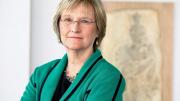The New York Times described it as the “first rigorously tested insight into the biology behind any common psychiatric disorder.” I regard it as an exemplary demonstration of the unmatched potential of the Harvard medical ecosystem. Steven McCarroll, associate professor of genetics at Harvard Medical School (HMS); working with Aswin Sekar, an MD-PhD student; drawing on the resources and human genome analysis of the Broad Institute of Harvard and MIT; and joining together with Beth Stevens, an assistant professor of neurology at Boston Children’s Hospital and Harvard, has provided what the Times hails as “a showcase of biomedical investigation at its highest level.” Their work offers unprecedented insight into how, through a process called synaptic pruning, genes can increase an individual’s risk of developing schizophrenia. This advance in the understanding of a devastating disease has the potential to lead ultimately to treatments and perhaps even cures. HMS, the Graduate School of Arts and Sciences, Harvard hospitals, and the Broad Institute joined together in this discovery as participants in an environment in which both researchers and pathbreaking science thrive.
One of the great pleasures and satisfactions of my job is learning about breakthroughs that emerge from the remarkable world of Harvard science and medicine. Happily, this is a quite regular occurrence. Last semester brought news of a genetic mutation that may help predict the risk of brain disorders in newborns with heart problems, an analysis of the response to Ebola that offers critical lessons for addressing future epidemics, a “human-gut-on-a-chip” that offers a new pathway to understanding inflammatory bowel diseases, and a faster method of using search data to track and monitor the flu created by two statisticians in the Faculty of Arts and Sciences (FAS) and a faculty member in the computational health informatics program at Boston Children’s Hospital who is also an applied mathematics lecturer at the Harvard Paulson School. In September, Stephen Elledge, the Gregor Mendel Professor of Genetics and of Medicine at HMS and Brigham and Women’s Hospital, received the 2015 Albert Lasker Basic Medical Research Award in recognition of his work describing “the DNA-damage response—a fundamental mechanism that protects the genomes of all living organisms.” Understanding the network that informs a cell of DNA damage, triggers repairs, and prevents mutations marks a significant advance in the effort to explain the origins of cancer.
The spring semester is off to an auspicious start with the publication of research on a pair of extraordinary devices. A group of researchers led by Don Ingber, founding director of the Wyss Institute for Biologically Inspired Engineering, Judah Folkman Professor of Vascular Biology at HMS and Boston Children’s Hospital, and professor of bioengineering at the Harvard Paulson School, unveiled a network of “vessels” that subjects blood to conditions found in the body and produces data that is analyzed in real time to predict when a clot will form. Less than three weeks later, a team of scientists at MIT, Harvard, and several other institutions announced a leap forward on the path to an effective treatment for type 1 diabetes. They have developed an implantable device that stops the immune system from attacking human insulin-producing beta cells that were themselves recently developed in the laboratory of Doug Melton, Xander University Professor and a member of the joint FAS-HMS Department of Stem Cell and Regenerative Biology. This collaboration between bioengineering and stem cell science across departments, schools, and even institutions brings clinical development—and a possible cure—within our grasp.
Crucial to these and so many other successes is location in a broader biotech community that constantly invests in translating promising ideas into applications and therapies, a so-called Massachusetts “supercluster” that comprises eight of top fourteen NIH-funded independent hospitals and attracted nearly $2 billion in venture capital in 2014. This spring, Provost Alan Garber and I regard the selection of a new dean for Harvard Medical School, a critical leader within this precious ecosystem, as among our very highest priorities. In the face of challenges to funding for scientific research and fundamental shifts in systems for the delivery of health care, we must sustain and extend Harvard’s leadership in bio-medicine and ensure that we fully realize the potential of this extraordinary community to contribute to the alleviation of human suffering.









